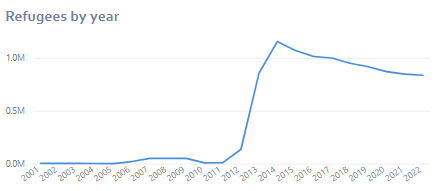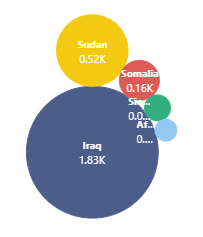Introduction
The orientation towards immigration is one of the most prominent features of Lebanese society throughout history, and since the establishment of the state until today, Lebanon has witnessed large waves of immigration that accompanied the critical stages in which it lived.
In parallel, Lebanon is witnessing a heavy turnout of refugees from various countries.
Is the number of these refugees now greater than the indigenous population in Lebanon?
Using power BI and the dataset collated by UNHCR, we will answer this question by sharing some figures on refugees and migrants in Lebanon in the last 21 years.
Distribution of refugee and immigrant’s countries in the world

The map in Fig.1 shows the distribution of countries of refugees coming to Lebanon. Noting that the cumulative number of these refugees reached about 10 million from 2001 until 2022.

The map in Fig.2 shows the distribution of the destination countries from the Lebanese immigrants. The number of immigrants in the same period reached about 331,960.
Evolution of the number of refugees and immigrants over time

We can say that the sum of refugees from 2002 until 2011 was low and stable, but after 2011 this number increased very quickly until it reached its peak with 1,154,029 refugees in 2014. Then it decreased with time, but it was still high.
The average of the sum of refugees before 2011 was 944.61/ year and after that year 23520/ year. So 2011 is the year that separates this big change.

As for the sum of immigrants from Lebanon, it was 28,677 in 2022 which is the highest number reached in a year, after that it continued to decline to reach its minimum of 6,539 in 2013. After this year, the sum of immigrants started to increase over time until today.
Top refugee’s origin countries

In 2001, Iraq was the origin of the highest number of refugees as we can see in the graph. 1830 Iraqi refugees were coming to Lebanon that year.

But over time, the number of Iraqi refugees becomes negligible in comparison to those from Syria which became the biggest origin country of refugees after 2011.
The graph above shows the top origin of refugees’ county in 2022 and 831050 Syrian refugees came to Lebanon in that one year only.

The countries that we see in the graph above are the top 5 refugee origin countries. And we can see the big difference between the sum of refugees coming from these countries, where Syria is the origin of the highest number of refugees with around 10 million over the past 20 years, while the number in other countries such as Iraq, Sudan… does not exceed 300,000.
Top destination countries from the Lebanese immigrants

Germany is the first country to receive Lebanese refugees (186,092), according to data collected by UNHCR, followed by Canada (26,008), the United States of America (19,839), Sweden (18,910), and Brazil (15,611).
The largest number of immigrants males or females?

Over the years, the number of males was always more than the number of females among the immigrants. The biggest difference was between 2009 and 2013, and between 2013 and 2017 while in the rest years the numbers were relatively close.
Conclusion
In summary, in the last 21 years, Lebanon is witnessing a massive turnout of refugees, especially from Syria with a cumulative sum of refugees close to 10 million, while the number of immigrants from it continues to rise since 2013 until the cumulative number reached 331,960. An official population census has not been conducted in Lebanon since 1932, and we don’t have an exact number of the population today, we only have estimations. So with these numbers; a minimum of 6,539 Lebanese immigrants and a number of refugees not less than 830,000 every year, we can say that the number of refugees has become very close to the population of Lebanon, and it is not excluded that it will exceed it in the coming years if the numbers continue to change in this way.
References
https://data.humdata.org/dataset/unhcr-population-data-for-lbn

Small analysis, interesting numbers.
The 2001 war in Iraq should have been mentioned as well as the 2011 war in syria